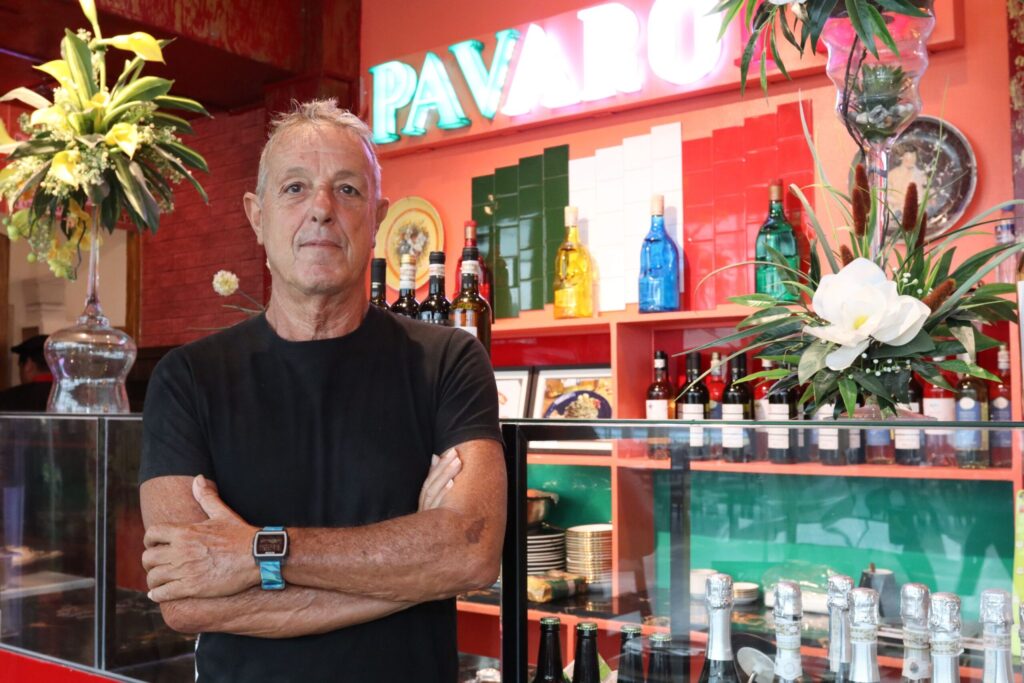Talk about authenticity without its boring and trite implications, Pavarotti is your best choice for a warm, comforting and pleasurable Italian repast. Thanks to Becky Garcia who invited me to sample their offerings — and thanks to an even earlier invitation from Jessie Maloles, a business partner in this venture, I could walk another mile for this delightful experience.
The warmth of the ambience, very hospitable in the Italian sense of the word, intimate and personal, very familial, is only matched by two gentlemen whom I had the pleasure of interviewing — Chef Gino Amodio and restaurant principal partner-cum-art director Marcoroberto Ascione. Marco’s partners are Jessie Maloles, Olah Gray Padilla Brady and Ralston Austin Dy.
Italian with an Asian twist
Gino Amodio has lived in the Philippines for the longest time. First, he settled in Boracay for more than 30 years, and after that, in Bantayan, Cebu for four years. He was an executive chef and industrial partner in Aria Restaurant in the Boracay Mall owned by the Elizaldes.
In 2018, after he retired, he joined Pavarotti as its consultant chef. The restaurant took a break during the pandemic and reopened just recently. I visited the restaurant on the third week of its renewed, more vigorous identity, one stomped with the mark of Chef Gino.
The jolly, articulate and naturally persuasive gentleman shared, “I brought here my experience in Italian cuisine. I do traditional Italian food but with a twist of Asian.”
What dishes would he recommend to his customers who are out to have a good filling time? He replied, “Oh, well. We have, for example, a nice Italian dish called Cannelloni. It’s a spinach ricotta cannelloni with béchamel and tomato sauce. It’s a new dish. I do all new dishes.”
“It’s not a very common dish. It’s a little bit like a regional specialty. For example, I use the excellent Philippine mango which I wrap in parma (ham).So, that is a combination of Italian excellence and Filipino excellence. And they are so sweet together.”

Pasta Amatriciana.
Traditional bruschetta and crostini with burrata
I asked him what good soup could he recommend. “I do pumpkin and cinnamon,” he replied with the enthusiasm of a boy eager to show his collection of tops or marbles. “And I do mushroom soup, porcini mushroom.”
It’s the first time he is doing consultancy work. Reputed to be efficient as a boss and chef, he enumerated his initial accomplishments. “I started with a light and easy menu. Because it’s been only a few days since I started. So, slowly I can teach the team. I want to teach them cooking and everything. So, let’s say it’s a work in progress right now. What you’re seeing is just a very soft opening.” For a soft opening, I told myself, this appears very professional and relaxed, no jitters at all.
For an entrée, he suggested “a traditional bruschetta.” And I did some crostini with burrata for you to enjoy. And I did this croquette with salmon. That’s the main dish. And we have a selection of salads that match the entrée.
“Like a salad with mozzarella and grapes. And then a salad of watermelon with cashew nuts and feta cheese. And a garden salad, and a traditional caprese with tomatoes, fresh mozzarella and basil.”

Originally a pizza-pasta joint
“This started as a fast food, a pizza pasta kiosk. I also did the menu in the beginning,” Gino said.
“Then, it developed into a full-fledged restaurant, but slowly. But its front is still working as a pizza-pasta joint complete with seats outside. So, we have a lot of walk-in traffic — children and families.”
Assisting him is Glen Bano whom he described as “a good chef, good cook and he heads the kitchen here. He has worked with Marco before in Venice.”

Italian salt
Shifting gears, I asked where he sources his ingredients. “Our most important ingredients are from Italy, like olive oil, peeled tomatoes, and pasta, of course. I use Italian pasta. I use Italian flour. Even salt. I prefer to use Italian salt in my kitchen because in Italy, we have a tradition in making salt. We dry sea water to produce salt. And Italian marine salt has a pretty distinctive taste in the dishes.”
When it comes to vegetables and fruits, “the best are always from the Philippines. Very fresh and tasty. Some of our pastas are vegetarian. Only few are meat. We don’t have too many seafood, but we have baked prawns. I cook them with garlic and rosemary, which is a classic. And I do a salmon aqua pizza.”

Art and good food
Marco, recalled, “I chose this space because I liked the fountain.”
Peripatetic since he was 14 years old “when I escaped to Paris, I have traveled all over the world. And so when we were conceptualizing the new Pavarotti, I thought about the beautiful things that I have seen, and we decided on putting art and good food together.
“Italian restaurants now are always casual. Casual is good but it’s not what I want. What I want is when you enter our door, and close it behind you, you feel Italy. You need to feel Italian music. You should hear ‘O Sole Mio’ or ‘Volare.’”
He blurted out his ideal, “Venice! So, I wanted to create something different. And fusion came flashing into my mind! Fusion in food is the key, the biggest thing to happen in the last 10 years. Every big chef wants a fusion. So, I do fusion.”
Marco swears by olive oil. “I eat everything with olive oil, every single thing. Even in Japanese restaurants, olive oil is also used even if they also have good sesame oil.”

Pavarotti’s art director
When he noticed that I was taking in the artistic atmosphere, he pointed at the paintings on the wall, explaining, “These are all my paintings in the art school. I was in love with impressionism so I went to Paris. I also worked as an artist in Venice. I did portraits at the San Marco Square. But the first time I went to Paris, I entered a museum and I was attracted to Degas, Gauguin, Van Gogh.”
As Pavarotti’s art director, a title he has assigned to himself, “I take care of the concept.”
Then, he quipped, “I ask diners right at the entrance if they are romantic, because if they are not, I tell them they cannot come it. It’s all a joke, of course. But, seriously, my ideal situation is if you’re not romantic and passionate, don’t come here anymore because this is the wrong space for you. Here, I want you to feel like you were really in Italy.”
Tomato is gold
As we were conversing, more food was placed on the table. “This one is Fornarina Pugliese. Because this focaccia comes from Puglia. Puglia is in the south of Italy.”
“It’s in the south of Italy, where this kind of focaccia is cooked and served only in one place. Every place has its own specialty. Fornarina Pugliese is cooked with olives and tomato. This one has cherry tomato baked to caramelize with oregano, thyme, salt and sugar. So, the taste is a little bit intense. You know, tomato for Italy is gold.”
Another dish, Pasta Amatriciana, “is made with bucatini pasta, tomatoes and guanciale, which adds a smoky flavor to the sauce, making it different from the usual tomato sauce.”
Finally, I asked him if he is happy to do business in the Philippines. He stared at me, and exclaimed, “I am not just happy here. I love it here. This is despite all the defects that people say about this country. There are more things to like, like the islands and the beaches. All it takes is a 20-minute seaplane ride and you’re right on a beautiful island. How can one not love this beautiful country of friendly people?”


